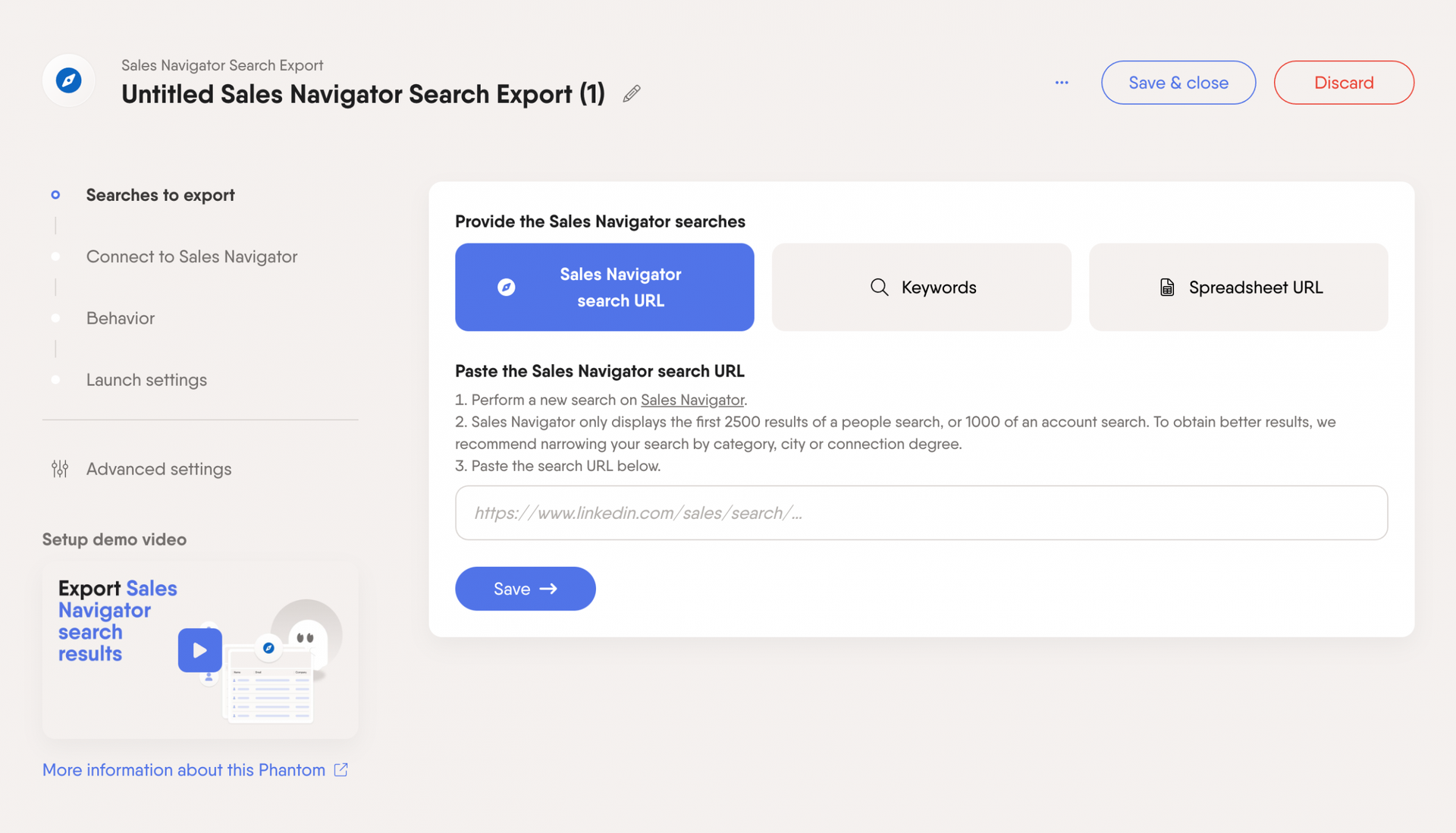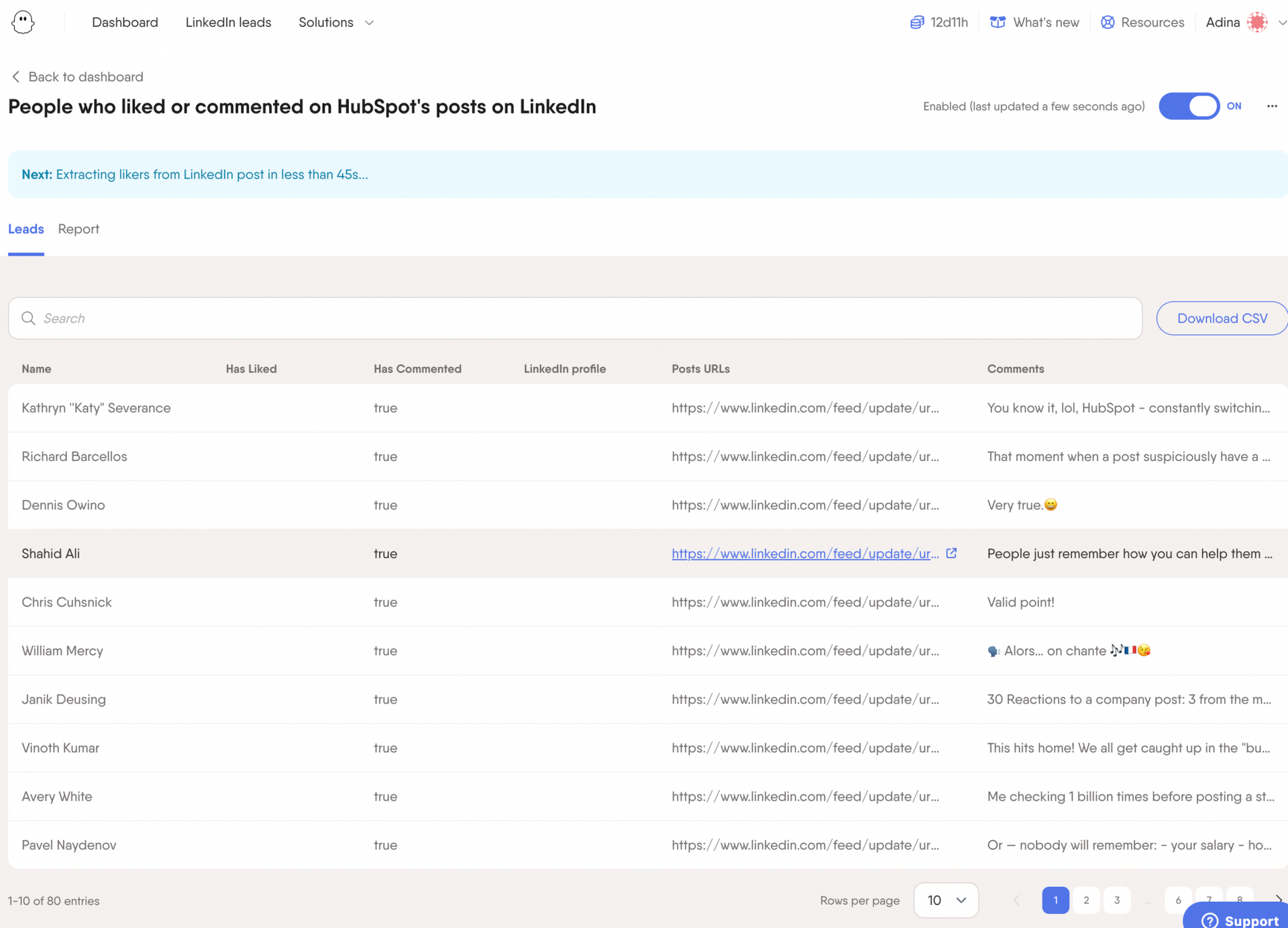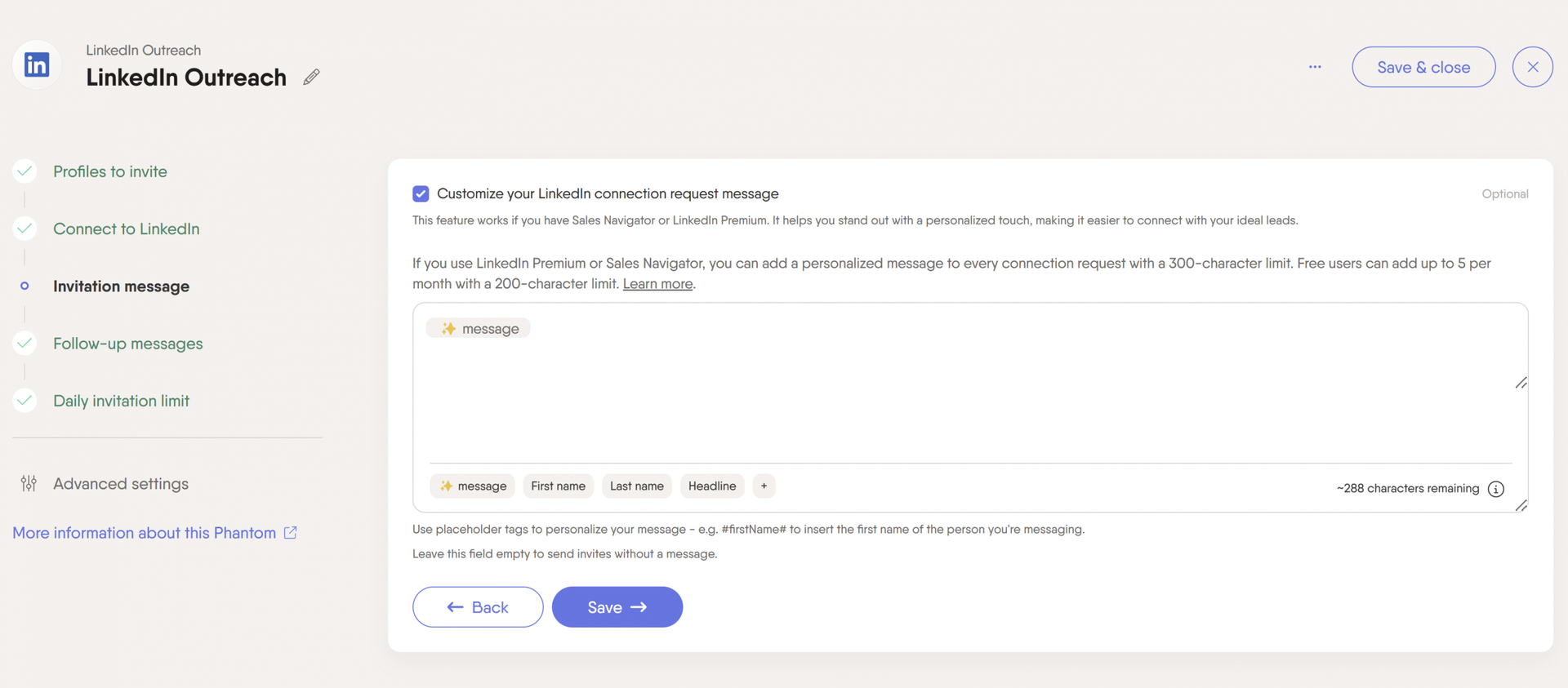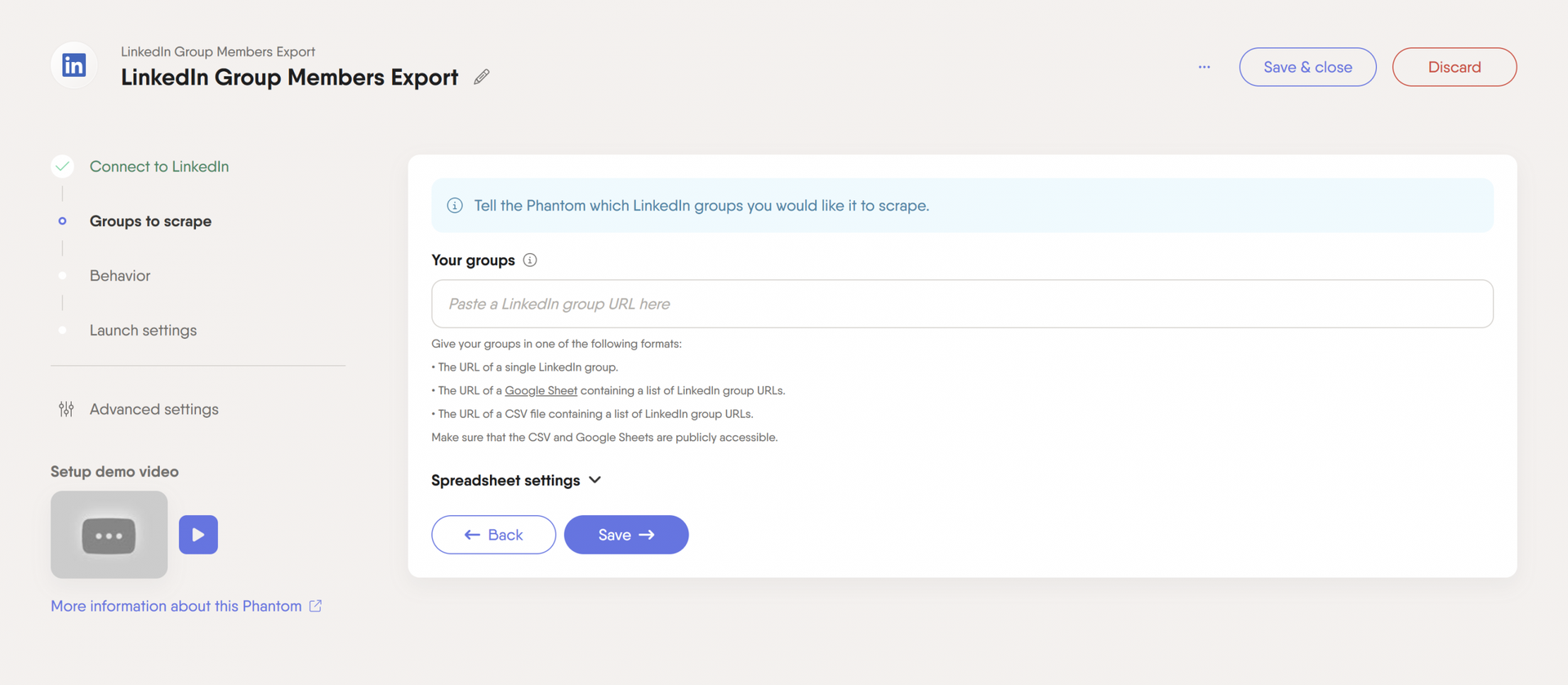The best sales reps consistently generate qualified leads and avoid wasting time on low-quality prospects. They use B2B lead generation to boost their own sales pipeline.
With AI prospecting tools and automation workflows, sales teams can identify, engage, and convert potential leads into customers without spending a lot of money.
AI highlights
This guide gives you 15 actionable tactics for B2B lead generation strategies you can start using today.
Here’s your quick-start action plan:
- Master LinkedIn: use Sales Navigator’s advanced filters (company size, industry, job title, Boolean searches) to pinpoint your ideal prospects. Extract lists with PhantomBuster’s LinkedIn Search Export and monitor job changes with PhantomBuster – a new role often means new opportunities.
- Warm up outreach: research prospects before contacting them. Check LinkedIn profiles for recent activity, company news, and mutual connections. Use PhantomBuster’s AI LinkedIn Message Writer for personalized openers.
- Listen socially: use social listening to identify prospects actively seeking solutions. Track relevant keywords and discussions on LinkedIn. Use PhantomBuster’s Post Engagement Scraper to find people engaging with competitor content or industry discussions.
- Automate lead generation: employ marketing automation tools like chatbots, automated email sequences, and lead scoring to nurture website visitors. Use PhantomBuster to automate lead extraction and enrichment from LinkedIn.
- Leverage employee networks: encourage employees to share content on LinkedIn. Then, use PhantomBuster’s LinkedIn Post Commenters/Likers Export to identify and extract engaged prospects.
- Target and personalize: focus on prospects matching your Ideal Customer Profile (ICP). Personalize messages based on their specific needs and online activity. Use account-specific information in ABM campaigns.
- Offer value: host webinars and offer gated demos to educate prospects and capture contact information.
- Use a CRM: track every interaction with prospects – emails, calls, social media engagement. Use the CRM to segment leads, prioritize outreach, and automate follow-ups. A CRM is essential for managing your pipeline effectively.
- Find ABM leads with Crunchbase: use Crunchbase’s filters (funding stage, employee count, industry, location, tech stack) to identify companies that fit your ideal customer profile for account-based marketing campaigns.
- Ask for referrals strategically: after a successful project or positive customer feedback, ask for referrals. Make it easy by suggesting specific connections they might have (e.g., “Do you know other marketing directors facing similar challenges?”).
- Use paid ads in ABM: target specific individuals at key accounts with LinkedIn Ads (filter by company, job title, industry). Personalize ad copy and landing pages with account-specific information.
- Cold calling (if used): if cold calling is part of your strategy, always research prospects beforehand. Warm calls are significantly more effective.
- Convert MQLs to SQLs with email: use segmented email sequences to nurture marketing-qualified leads (MQLs). Provide valuable content that addresses their specific pain points and gradually moves them towards becoming sales-qualified leads (SQLs).
- Use prospecting tools: automate tasks and save time. Use PhantomBuster to streamline your LinkedIn prospecting, data extraction, and lead enrichment. Try it free today!
1. Use LinkedIn Sales Navigator’s Advanced Filters
Using LinkedIn’s filters, you can target searches based on the profiles of your current customers and potential customers.
Combine company industry, size, and job title criteria for highly targeted searches. Or use Boolean search strings for more complex searches:
Example: (“VP of Sales” OR “Head of Sales” OR “Sales Director”) AND (“SaaS” OR “Software”) AND “Series B”), geographic targeting, growth indicators, and recent company changes.

After you’ve refined your search, use PhantomBuster’s LinkedIn Search Export to get a list of prospects. Copy and paste the LinkedIn Sales Navigator URL into the Phantom.

2. Warm up cold calls with pre-call research
Instead of cold calling, modern sales reps examine prospects’ LinkedIn profiles and use automation to detect when they’ve changed jobs or received a promotion. Check for any valuable information like that before you reach out. You can use PhantomBuster’s AI LinkedIn Message Writer to create personalized opening messages like these:
“Hi Mark, I noticed your company just expanded into the APAC region. Many of our clients faced similar scaling challenges during their expansion…”
Spend 5-10 minutes researching each prospect’s recent company news, professional achievements, mutual connections, and shared interests to boost meeting bookings.
With automation tools, you can enrich contact lists and personalize messages while keeping the personal touch.
3. Use social listening tools to identify intent signals
Monitor LinkedIn keywords and conversations to find leads actively seeking solutions. Pay attention to people looking for alternatives to competitors, asking for product recommendations, complaining about their service provider, or looking for solutions to specific problems.
PhantomBuster’s Post Engagement Scraper automates this sales process by monitoring relevant LinkedIn posts about competitors’ content.
It automatically generates prospect lists using challenge posts, likes, and comments.

4. Track old sales leads job title changes
Career moves of your leads and potential buyers can often create new sales opportunities. Monitor their career moves so you can contact them when it’s convenient.
Tracking your contacts will help you learn about sales opportunities and ideal prospects. For example, whenever a former top sales department lead becomes a director or joins the top sales team of a company that fits your target customer profile, you can reach out with a targeted message.
PhantomBuster’s Job Change Monitor automates the tracking process:
- Monitors your lead list for job updates
- Sends notifications when changes occur
- Maintains an updated spreadsheet of changes
- Flags potential opportunities based on new roles
Here’s a quick message template for job changes. You can use AI to generate this and automate outreach using PhantomBuster.
“Congratulations on your new role as [Title] at [Company]! Would love to show you how we help other [similar position] improve their [relevant benefit].”

Keep track of your past leads, especially those who didn’t convert. A well-timed message to someone in a new role often leads to a good conversation.
5. Extract leads and prospects from relevant LinkedIn groups or event attendees
The LinkedIn community is a great place to find new contacts interested in your product.
If you’re generating sales leads, consider joining a professional group focused on specific industries, roles, or technologies. For example, people interested in marketing tools may belong to a group called “Automated Marketing Professionals.”
PhantomBuster’s Group Member and Event Extractor streamlines building a lead list from group members. With it, you can:
- Extracts member lists from relevant groups
- Collects attendee information from events
- Gathers profile details automatically
- Creates organized CSV files for outreach

Pro tip: Focus on groups that have consistent, professional discussions rather than excessive self-promotion.
6. Use marketing automation to enhance B2B lead generation efforts
Automated marketing can drive traffic and turn website visitors into qualified leads. Solutions include chatbots, automated emails, and personalized content on landing pages.
Use automation to qualify leads based on behavior and engagement with the company website. You can score and website visitors based on contact data, chatbot interactions, resource downloads, and product pages visited.
7. Use email marketing to convert MQLs into SQLs
As Marketing Qualified Leads (MQLs) receive relevant, value-focused content, they naturally progress to Sales Qualified Leads (SQLs).
With email segmentation, you can send the right message to the right person at the right time. Create targeted campaigns based on industry, company size, engagement level, or specific pain points.
An effective email sequence structure often includes:
- A welcome email offering valuable industry insights.
- Problem-focused content addressing common pain points.
- A solution overview featuring customer success stories.
- An invitation to a product demonstration.
- A special offer or a consultation call.
Jed Mahrle, founder of Practical Prospecting, wrote a sample nurture email you can adapt:

Before scaling successful templates to larger groups, we recommend testing different email variations with small segments. This allows you to optimize for the best results.
8. Host webinars to attract prospects
Webinars are a great way to educate prospects about industry solutions and collect sales leads.
For a webinar to be effective, it needs relevant topics, engaging presentations, and interactive elements. Include Q&A sessions, polls, and practical demonstrations to address attendees’ concerns.
Planning a successful webinar involves:
- Choosing topics that address common pain points within your target audience.
- Promoting the webinar across multiple channels (email, social media, etc.).
- Sending reminder sequences to maximize attendance.
- Recording the session for on-demand viewing.
- Following up with attendees, providing valuable resources and next steps.
For example, our on-demand webinar “How to leverage intent signals to source leads on LinkedIn & Sales Navigator ” session attracts over 1000 marketing professionals interested in scaling their outreach monthly.

Of course, the ideal frequency for hosting live webinars depends on your target audience, company size, and other content marketing resources. We recommend always prioritizing practical, valuable content over purely promotional material.
Using webinars is also a great way to introduce prospects to industry solutions. The best ones mix relevant topics, engaging presentations, and interactive elements. Questions, polls, and practical demos answer attendees’ questions.
Make sure you decide if you want to hold monthly or quarterly webinars based on your target audience.
9. Use gated demos on your website
Gated demos allow prospects to see how your solution works without committing to a sales call.
By offering instant product walkthroughs, you let visitors explore features at their own pace – and you collect their contact information in return.
The Gong demo page below is a good example of an effective demo landing page.
Notice the clear value proposition, “See Gong in Action.”
This is followed by a brief description of what visitors will learn, a visual preview of the interface, and a prominent call to action (CTA). We’ve seen that this type of clear, benefit-focused presentation works well.

10. Try Crunchbase to find more high-quality leads for ABM campaigns
Account-based marketing (ABM) needs accurate company data to bring results. Crunchbase is valuable for finding detailed company information, including funding rounds, acquisitions, and growth indicators.
For example, if you’re building a list of target accounts, you might search for North American SaaS companies with 50-200 employees.
There are a lot of Crunchbase filters you can use:
- Stage and amount of funding
- Employee count ranges
- Industry and sub-industries
- Geographic locations
- Technology stack details
Experiment with different filter combinations to identify the best prospects for your ABM campaigns.
11. Ask for referrals among existing customers
Referral programs allow you to turn customer satisfaction into new business opportunities.
The best time to request a referral is after a successful project, high Net Promoter Score (NPS) results, or when a customer shares positive feedback.
Here’s a simple process for requesting referrals from existing customers:
- Identify happy customers: Focus on those who have had positive experiences.
- Schedule a brief feedback call: This lets them discuss their satisfaction and naturally transition to the referral request.
- Inquire about their network: Ask if they know others who might benefit from your solution.
- Simplify the process: Make it easy for them to connect you with potential leads.
- Show appreciation: Thank your customers for their referrals.
Here’s a sample referral request you can adapt:
“Do you know other sales and marketing teams or directors in your network who have faced similar challenges? I’d appreciate it if you could introduce me to them.”
Remember to check in regularly with your loyal customers about potential referrals and prioritize these valuable connections. Consistent follow-up is key to a successful referral program.
12. Paid ads as part of ABM campaigns
Pay-per-click (PPC) advertising, especially on platforms like LinkedIn Ads, lets you target specific individuals within your key accounts. Instead of broad marketing, you can use LinkedIn’s precise targeting (company name, job title, industry) to reach decision-makers directly.
For example, you could create a valuable “State of [Prospect’s Industry]” report and promote it exclusively to those key people at your target accounts. This is far more effective than generic ads.
To increase effectiveness, personalize your ad copy with account-specific pain points:
“Solve [Company X]’s specific [Industry] challenges.”
Dynamic landing pages automatically include the visitor’s company name, creating a tailored experience. Consider combining LinkedIn targeting with intent data to reach prospects actively researching solutions.
It’s all about being relevant and timely.
Start small, focusing on a few priority accounts. Test different approaches to find what resonates best with your target audience.
13. Cold-calling potential prospects
While cold calling remains a common practice, success rates have declined. Generating warm leads is generally more effective and efficient than purchasing contact lists and making hundreds of generic calls.
However, companies with sufficient resources and a dedicated sales development team can still succeed with cold calling if they prioritize thorough research and personalization.
The current challenges with cold calling include:
- It takes more dials to secure a single connection.
- Meeting conversion rates are lower.
- Prospects are more resistant to unsolicited calls.
- There are limited options for personalization within a cold call itself.
Here are some alternative approaches:
- Focus on inbound leads
- Nurture existing contacts
- Use social selling methods
- Connect through mutual contacts
If you choose to include cold calling in your strategy, always warm up new prospects before making the call.
If your sales and marketing team has the capacity, adopt a structured approach that emphasizes in-depth research and personalized messaging. This significantly increases your chances of success.
14. Use prospecting tools to automate finding warm leads
Sales teams can now find fresh, warm sales leads with automation tools instead of manually prospecting. This significantly improves efficiency in finding new leads.
You can use PhantomBuster to automate lead prospecting by extracting and enriching leads with LinkedIn data.
For example, a B2B software company could use PhantomBuster to:
- Extract contact details from participants in a relevant LinkedIn event
- Identify decision-makers who recently commented on industry trend posts
- Find professionals who’ve just changed jobs and moved into target roles
- Discover companies actively posting about challenges your product solves
Instead of spending time gathering data manually, use automation tools to maintain a consistent flow of high-quality leads.
15. Leverage employee networks for referral leads
Your employees’ professional networks are a valuable, often untapped, source of leads especially when they actively advocate for your product or service on social media.
They likely have connections with qualified prospects who match your target audience, which will make your message more likely to resonate.
Start by helping employees become brand advocates.
For example, provide shareable content (blog posts, case studies, company updates) and encourage them to post about your product/service on platforms like LinkedIn.
The key is authentic advocacy. They should share insights and experiences, not just copy-paste marketing messages.
Next, track social media engagement generated by employees’ content with PhantomBuster.
Use PhantomBuster’s tools like the LinkedIn Post Commenters and Likers Export to extract the profiles of people who have liked, commented on, or interacted with these posts.
These individuals have already shown some level of interest, making them warm leads.
Once you have a list of engaged prospects from PhantomBuster, you can then use that data for targeted outreach.
You can personalize your messages based on the specific post they engaged with, referencing your employee’s connection:
“Hi [Prospect Name], I saw you commented on [Employee Name]’s post about [Topic]. I thought you might be interested in…”.
This approach combines the power of employee advocacy with the precision of automated lead extraction. It’s far more effective than relying on generic referral requests or cold outreach.
FAQs about B2B lead generation
What is B2B lead generation?
B2B lead generation involves understanding businesses’ needs and creating engagement strategies to attract potential customers and generate more leads. It’s about connecting with the right people at the right time. To generate leads, sales teams use social selling, content marketing, and targeted outreach.
What’s the difference between a MQL and a SQL?
Marketing-qualified leads (MQLs) show interest in your product or service but are not quite ready to buy. They’re still in the “awareness” stage. In comparison, sales-qualified leads (SQLs) are actively considering a purchase. They might request pricing information, a product demo, or express direct interest. SQLs are ready for direct sales engagement.
What are some common challenges in finding B2B leads?
Finding the right contacts in B2B can be tricky because decision-making structures are often complex. Multiple stakeholders are usually involved, and roles can change frequently. This makes identifying the right people and keeping your data up-to-date a constant challenge.
The key is to attract prospects who closely match your Ideal Customer Profile (ICP) and offer them a compelling value proposition that sets you apart.
How do you qualify B2B leads during the sales process?
Qualifying leads is about making sure they’re a good fit. Ask yourself:
- Does the company fit your ideal customer size and industry?
- What are their specific challenges and needs?
- Do they have the budget and authority to make a purchase decision?
- Are they engaging?
Keep track of their responsiveness and establish a clear timeline for next steps.
What tools can I use to find B2B leads to fuel my sales pipeline?
There are multiple automation tools you can use to generate pipeline:
- LinkedIn Sales Navigator helps you find decision-makers.
- PhantomBuster enhances your lead generation data with real-time information.
- Email marketing allows for targeted campaigns.
- CRM (Customer Relationship Management) systems help you track leads, manage interactions, and prioritize your efforts.
For example, you can leverage employee advocacy, as we talked about earlier. Encourage your team to share insights on LinkedIn, then use PhantomBuster to collect data on users engaging with these posts.
